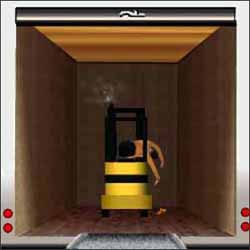Spot The Safety Violation: Powered Equipment + Enclosed Area = CO Hazard
What do you think caused the worker depicted above to pass out’

Many workplaces use equipment and tools powered by gasoline, diesel, propane and the like. If such equipment is used in an enclosed space and without adequate ventilation, it can put workers in grave danger.
This picture from OHSA illustrates what can happen when forklifts powered by internal combustion engines are used in enclosed work areas, such as inside a truck’high levels of carbon monoxide can build up, causing workers to lose consciousness and even die.
Tragically, carbon monoxide (CO) incidents are far too common:
- A security guard at a wind farm in Nova Scotia and a friend who was visiting him were overcome by fumes from an improperly installed electrical generator in a maintenance shed. The employer pleaded guilty to three OHS violations, including failing to ensure the generator was properly installed and operated, and was fined $95,000.
- In Newfoundland, several warehouse workers were hospitalized for CO poisoning. They were in a warehouse operating and working around propane-powered fork lift trucks, which appeared to be the source of the contaminant.
- In BC, three construction workers had to be treated for CO poisoning due to the improper use of a gas-powered space heater they were using to warm a building that was under construction. (See, portable heater requirements and space heater safety checklist.)
- A farm worker in Qubec died of CO poisoning after using a gas-powered pressure washer to clean a non-ventilated pigsty inside a building.
10 STEPS TO PROTECT WORKERS FROM CARBON MONOXIDE
Here are 10 basic steps that employers can take to protect workers from carbon monoxide:
- Install and properly maintain an effective ventilation system that will remove CO from work areas or require workers to use appropriate respiratory protection.
- Maintain equipment and appliances that can produce CO, including powered mobile equipment, space heaters, water heaters and generators, in good working condition to promote their safe operation and to reduce the creation of CO.
- Always install and use equipment according to the manufacturer’s instructions.
- Consider switching from equipment powered by gasoline and similar fuels to ones powered by electricity, batteries or compressed air if they can be used safely.
- Bar the use of gasoline- or propane-powered equipment in poorly ventilated areas.
- If workers are working in confined spaces where the presence of CO is suspected, ensure that they test for oxygen sufficiency before entering.
- Monitor the air in areas where CO may be present, including enclosed areas, to ensure that CO levels remain within occupational exposure limits.
- Install CO monitors with audible alarms.
- Give workers personal CO monitors with audible alarms if potential exposure to CO exists.
- Educate workers about the sources and conditions that may result in CO poisoning as well as the symptoms and control of CO exposure.